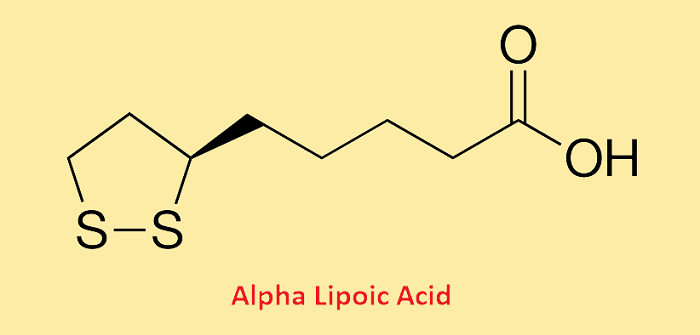Lipoic Acid
Lipoic acid (LA) also goes with the names alpha-lipoic acid (ALA) and thioctic acid. It is an organosulphur compound, which is obtained from caprylic acid. It is synthesized naturally in our body and plays a vital role in aerobic metabolism as it breaks down carbohydrates to produce energy. It is also produced and consumed as a dietary supplement in some countries that market it as an antioxidant. It was first isolated in 1951 by Reed and his colleagues. It was formerly classified as a vitamin by Rosenberg and Culik in 1959.

Physical Properties of Lipoic Acid:
- It has two sulphur (S) atoms at carbon atoms C6 and C8. These sulphur atoms are bonded by a disulphide bond.
- The C6 carbon atom is chiral and its molecule is found as two enantiomers: (R)-(+)-lipoic acid (RLA) and (S)-(-)-lipoic acid (SLA) and in the form of a racemic mixture (R/S)-lipoic acid.
- It appears as a yellow solid.
- It has a terminal carboxylic acid and a terminal dithiolane ring.
Importance of Lipoic Acid:
It is an important antioxidant owing to its ability to neutralize harmful compounds (free radicals) that damage cells. It has been nicknamed the 'universal antioxidant' as it is found in every cell of our body. Our body can synthesize ALA, however, it can be obtained from some foods and is also available as a supplement. The foods rich in ALA are carrots, beets, spinach, broccoli, potatoes, red meat, and more.
Uses of Alpha-Lipoic Acid
- It can aid in maintaining the glucose level by increasing the metabolism of blood sugar. Thus, it can help manage diabetes, which occurs due to high levels of blood glucose.
- It may promote the burning of calories and thus help weight loss. It improves metabolism that breaks down more sugars and fats for energy rather than storing them as fat.
- It helps prevent macular degeneration which is caused by oxidation. For example, ALA recycles vitamin E that helps slow down the progression of macular degeneration. Thus, it helps improve vision.
- Being a powerful antioxidant, it can scavenge free radicals and help prevent oxidative stress. Further, it aids in the removal of toxic metals from the body.
- It regenerates and improves other antioxidants such as vitamin C and E, glutathione and coenzyme Q10.
- It helps chronic wounds heal quickly and when applied to the skin it reduces dryness and damage due to sun in old patients. As per some studies, it can also reverse skin damage caused by smoking.
- It is found effective in various neurological disorders, according to some studies, it may restore damaged neurons.
- It promotes muscle regeneration after injury by changing the internal chemistry of cells.
- It is found in clinical trials that its intake reduces the level of bad cholesterol and triglyceride and increases the level of good cholesterol. As per some studies, it can prevent the hardening of arteries. Thus, it is good for heart health.
- It helps prevent hypertension (high blood pressure) by reducing the inflammatory cytokines in the blood.
- It helps prevent bone loss caused by inflammation and helps treat loss of cartilage due to osteoarthritis.
- It helps reduce migraines by reducing oxidative stress and mitochondrial dysfunction. Further, it also boosts the efficacy of topiramate, a medication used to treat migraine.
- According to some studies, the intake of a diet rich in ALA can boost total sperm count as well as sperm concentration and motility.
- It is good for the health of mother and child in high-risk pregnancies. Further, its intake also reduces the chances of miscarriage.
- It may activate the enzyme telomerase, which can slow down aging process. Thus, it may increase the lifespan.
Dosage
The doctor can tell what dose is best for a specific condition. However, it is generally taken by adults orally in doses of 600-800 mg a day for up to 6 months.
Side Effects
The intake of alpha-lipoic acid is generally well-tolerated. It is safe when taken for up to 4 years by adults. However, the common side effects of its intake are heartburn, nausea, vomiting and headache.
Further, it is also safe when applied to the skin as a cream for up to 12 weeks. However, it may cause rashes in some people.
|

 For Videos Join Our Youtube Channel: Join Now
For Videos Join Our Youtube Channel: Join Now










